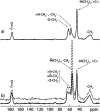Poly[2-(dimethylamino)ethyl methacrylate- co-ethylene dimethacrylate]nanogel by dispersion polymerization for inhibition of pathogenic bacteria
- PMID: 35497568
- PMCID: PMC9042309
- DOI: 10.1039/d1ra06231j
Poly[2-(dimethylamino)ethyl methacrylate- co-ethylene dimethacrylate]nanogel by dispersion polymerization for inhibition of pathogenic bacteria
Abstract
Bacterial infections and antimicrobial resistance are one of the major public health problems and various strategies to prevent potential threats have been developed. Protonated polymers were proven as efficient agents against several microbial pathogens. Poly[2-(dimethylamino)ethyl methacrylate] (PDMAEMA) linear polymer and its copolymers represent one example of functional materials which inhibit the growth of both harmful Gram-negative and Gram-positive bacteria. However, the antimicrobial effect of positively charged PDMAEMA particles has been never tested. In this report, we deeply studied several parameters of free-radical polymerization, including the effect of crosslinking monomer, medium composition, solvency and polarity, and type and concentration of initiator and stabilizer, to fabricate high-quality poly[2-(dimethylamino)ethyl methacrylate-co-ethylene dimethacrylate] (PDMAEMA-EDMA) nanogel. We successfully found that dispersion polymerization in water/2-methoxyethanol medium (80/20 w/w), initiated with 0.2 wt% potassium persulfate (KPS) and stabilized with 0.5 wt% poly(vinyl alcohol) (PVA), produced a well-defined and sub-micron 167 nm PDMAEMA-EDMA nanogel. Bactericidal activity of the quaternized PDMAEMA-EDMA nanogel was assessed via time-kill curve assay against two Gram-positive and Gram-negative pathogenic bacteria, namely Staphylococcus aureus (S. aureus) and Acinetobacter baumannii (A. baumannii). The results illustrated that the quaternized PDMAEMA-EDMA nanogel acted as an effective bactericidal agent against both tested bacteria.
This journal is © The Royal Society of Chemistry.
Conflict of interest statement
There are no conflicts to declare.
Figures







Similar articles
-
Responsive Quaternized PDMAEMA Copolymers with Antimicrobial Action.Polymers (Basel). 2021 Sep 9;13(18):3051. doi: 10.3390/polym13183051. Polymers (Basel). 2021. PMID: 34577950 Free PMC article.
-
Antibacterial effects of poly(2-(dimethylamino ethyl)methacrylate) against selected gram-positive and gram-negative bacteria.Biomacromolecules. 2010 Feb 8;11(2):443-53. doi: 10.1021/bm901166y. Biomacromolecules. 2010. PMID: 20025269
-
Film Properties and Antimicrobial Efficacy of Quaternized PDMAEMA Brushes: Short vs Long Alkyl Chain Length.Langmuir. 2020 Apr 7;36(13):3482-3493. doi: 10.1021/acs.langmuir.9b03266. Epub 2020 Mar 25. Langmuir. 2020. PMID: 32168453
-
Resistance of Staphylococcus aureus to the cationic antimicrobial agent poly(2-(dimethylamino ethyl)methacrylate) (pDMAEMA) is influenced by cell-surface charge and hydrophobicity.J Med Microbiol. 2011 Jul;60(Pt 7):968-976. doi: 10.1099/jmm.0.025619-0. Epub 2011 Mar 10. J Med Microbiol. 2011. PMID: 21393458
-
Micro/nanosystems and biomaterials for controlled delivery of antimicrobial and anti-biofilm agents.Expert Opin Ther Pat. 2020 Dec;30(12):983-1000. doi: 10.1080/13543776.2020.1839415. Epub 2020 Nov 3. Expert Opin Ther Pat. 2020. PMID: 33078643 Review.
Cited by
-
Recent Advances in Antimicrobial Nano-Drug Delivery Systems.Nanomaterials (Basel). 2022 May 29;12(11):1855. doi: 10.3390/nano12111855. Nanomaterials (Basel). 2022. PMID: 35683711 Free PMC article. Review.
-
Cellulose-g-poly(2-(dimethylamino)ethylmethacrylate) Hydrogels: Synthesis, Characterization, Antibacterial Testing and Polymer Electrolyte Application.Gels. 2022 Oct 7;8(10):636. doi: 10.3390/gels8100636. Gels. 2022. PMID: 36286137 Free PMC article.
-
Antimicrobial and anti-biofilm activity of Polygonum chinense L.aqueous extract against Staphylococcus aureus.Sci Rep. 2022 Dec 20;12(1):21988. doi: 10.1038/s41598-022-26399-1. Sci Rep. 2022. PMID: 36539472 Free PMC article.
-
Polymer-Antimicrobial Peptide Constructs with Tailored Drug-Release Behavior.Pharmaceutics. 2023 Jan 25;15(2):406. doi: 10.3390/pharmaceutics15020406. Pharmaceutics. 2023. PMID: 36839728 Free PMC article.
References
-
- Voorn D. J. Ming W. van Herk A. M. Macromolecules. 2005;38:3653–3662. doi: 10.1021/ma0475030. - DOI
-
- Natu A. M. Wiggins M. van de Mark M. R. Colloid Polym. Sci. 2015;293:1191–1204. doi: 10.1007/s00396-015-3508-9. - DOI
-
- Liu Q. Li Y. Duan Y. Zhou H. Polym. Int. 2012;61:1593–1602. doi: 10.1002/pi.4347. - DOI
LinkOut - more resources
Full Text Sources
Miscellaneous

